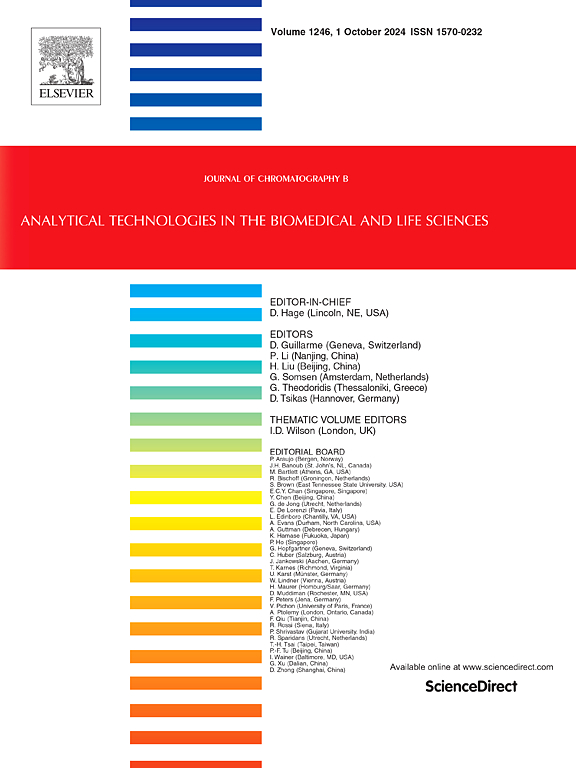元参方的化学-药理学连续体:综合成分-组织暴露相关性为糖尿病肾病靶网络提供信息
IF 2.8
3区 医学
Q2 BIOCHEMICAL RESEARCH METHODS
引用次数: 0
摘要
本研究旨在揭示元坎方治疗糖尿病肾病(DKD)的物质基础和作用机制。利用UHPLC-Q-Exactive Orbitrap HRMS和AB Sciex Triple Quad™4500 LC-MS,对YCF的化学成分进行了全面的定性和定量分析。共鉴定出166种化合物,其中黄酮类化合物57种,萜类化合物32种,有机酸类化合物25种,苯丙类化合物15种,建立了主要分类的碎片化模式,并研究了其组织分布特征。体内分布研究确定了存在于血液和肾脏中的原型化合物,并通过峰面积筛选和方解法验证,选择了8个关键化合物(仙球内酯H、仙球内酯I、诺比列素、3-正丁基苯thalide、仙球内酯A、甲基nissolin、阿魏酸和对香豆酸)进行药代动力学分析。这些化合物具有吸收快、滞留时间长、药理潜力强等特点。通过整合TCMSP、SwissTargetPrediction等数据库的数据,构建化合物靶标-疾病网络,通过GO和KEGG富集分析揭示YCF主要通过AGE-RAGE、PI3K-AKT和MAPK等通路发挥作用,从而调节氧化应激、炎症和纤维化。这些发现强调了YCF在治疗DKD中的多组分、多靶点和多途径协同作用的性质。总的来说,本研究阐明了YCF的体内行为和有效成分,同时构建了科学的机制网络,为探索中药方剂治疗复杂疾病提供了系统的药理学模型。本文章由计算机程序翻译,如有差异,请以英文原文为准。
The chemical-pharmacological continuum of Yucan formula: Integrated component-tissue exposure correlation informs diabetic kidney disease target network
This study focuses on uncovering the material basis and therapeutic mechanisms of the Yucan Formula (YCF) in the treatment of diabetic kidney disease (DKD). Utilizing a combination of UHPLC-Q-Exactive Orbitrap HRMS and AB Sciex Triple Quad™ 4500 LC-MS, a comprehensive qualitative and quantitative analysis of YCF's chemical constituents was performed. A total of 166 compounds were identified, primarily flavonoids (57), terpenoids (32), organic acids (25), and phenylpropanoids (15), with fragmentation patterns established for the major classes and tissue distribution characteristics investigated. In vivo distribution studies identified prototype compounds present in both blood and kidney, and through peak area screening and methodological validation, eight key compounds (Senkyunolide H, Senkyunolide I, Nobiletin, 3-n-Butylphthalide, Senkyunolide A, Methylnissolin, Ferulic Acid and p-Coumaric acid) were selected for pharmacokinetic analysis. These compounds demonstrated rapid absorption, prolonged retention time, and strong pharmacological potential. By integrating data from TCMSP, SwissTargetPrediction, and other databases, a compound–target–disease network was constructed, revealing through GO and KEGG enrichment analyses that YCF primarily exerts its effects via pathways such as AGE-RAGE, PI3K-AKT, and MAPK, thereby regulating oxidative stress, inflammation, and fibrosis. These findings highlight the multi-component, multi-target, and multi-pathway synergistic nature of YCF in the treatment of DKD. Collectively, this study elucidates the in vivo behavior and active constituents of YCF while constructing a scientific mechanism-based network, offering a systematic pharmacological model for exploring traditional Chinese medicine formulas in the management of complex diseases.
求助全文
通过发布文献求助,成功后即可免费获取论文全文。
去求助
来源期刊

Journal of Chromatography B
医学-分析化学
CiteScore
5.60
自引率
3.30%
发文量
306
审稿时长
44 days
期刊介绍:
The Journal of Chromatography B publishes papers on developments in separation science relevant to biology and biomedical research including both fundamental advances and applications. Analytical techniques which may be considered include the various facets of chromatography, electrophoresis and related methods, affinity and immunoaffinity-based methodologies, hyphenated and other multi-dimensional techniques, and microanalytical approaches. The journal also considers articles reporting developments in sample preparation, detection techniques including mass spectrometry, and data handling and analysis.
Developments related to preparative separations for the isolation and purification of components of biological systems may be published, including chromatographic and electrophoretic methods, affinity separations, field flow fractionation and other preparative approaches.
Applications to the analysis of biological systems and samples will be considered when the analytical science contains a significant element of novelty, e.g. a new approach to the separation of a compound, novel combination of analytical techniques, or significantly improved analytical performance.
 求助内容:
求助内容: 应助结果提醒方式:
应助结果提醒方式:


